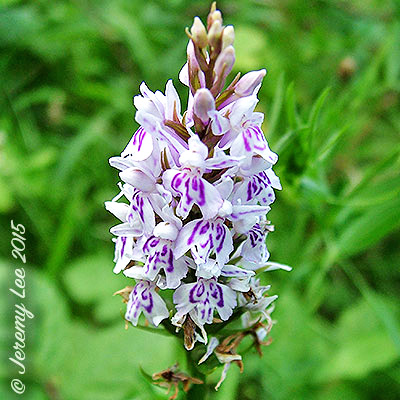
 |
|
Scientific Classifications explained » Amphibians » Ants » Aphids » Bees » Beetles » Birds » Bugs » Butterflies » Caterpillars » Damselflies » Dragonflies » Earwigs » Flies » Frog/Leafhoppers » Fungi » Galls » Grasshoppers » Harvestmen » Hoverflies » Lacewings » Ladybirds » Leaf Mines » Lichens » Mammals » Millipedes » Mosses » Moths » Sawflies » Slugs » Snails » Spiders » Trees & Shrubs » Wasps » Wild Flowers » Woodlice » Postboxes |
UK Nature > Wild Flowers > Red & Pink Wild Flowers > Dactylorhiza fuchsii

Common Name: Common Spotted Orchid Scientific Name: Dactylorhiza fuchsii The Common Spotted orchid is the most common of all UK orchids and the one you are most likely to see. It grows in many different habitats including woodland, roadside verges, hedgerows, old quarries, sand dunes and marshes; sometimes so many flowers appear together that they carpet an area with their delicate, pale pink spikes. It is in bloom between June and August. The Common Spotted orchid gets its name from its leaves which are green with abundant purplish oval spots. They form a rosette at ground level before the flower spike appears; narrower leaves sheath the stem. The flowers range from white and pale pink through to purple, but have distinctive darker purple spots and stripes on their three-lobed lips. The flowers are densely packed in short, cone-shaped clusters. Apart from the Scottish Highlands, the common spotted-orchid is found throughout the UK in damp grassland and open woods, flowering from June to July. |
|

https://www.uknature.co.uk is a website dedicated to showing the immense diversity of UK nature and wildlife. Our vast range of habitats, from lowland arable to snow covered mountains, from storm-ravaged coastlines to peaceful inland freshwater lakes and rivers, from dry, sandy heaths to deciduous and coniferous forests, all these habitats contribute to the abundance of UK nature. We have wild birds in huge numbers either residing or visiting our shores (597 recorded species as at July 2013) and we must also not forget the humble back garden with its grass lawns, flower beds filled with nectar rich flowers, shrubs and trees, all designed to attract huge numbers of insects such as bees, moths, butterflies and hoverflies; and finally the small ponds which provide safe havens for frogs, toads, newts and even slow worms and grass snakes. www.uknature.co.uk is the showcase for my personal passion, photographing uknature in all its glory. I sincerely hope you all enjoy the fruits of my labours. This site and all images contained therein is © Jeremy Lee 2004 - 2025. All Rights Reserved. Site design by Jeremy Lee. Site development & IT Support by Stuart Lee. |